Les actualités du Samedi 23 juillet 2016 dans les métiers du web - Marmits.com - Reims
 L’adaptation d’un texte à la culture locale, le choix des bons mots-clés et la prise en compte des différents dialectes sont les principaux facteurs de succès lorsqu’on envisage de traduire une boutique en ligne en allemand.
L’adaptation d’un texte à la culture locale, le choix des bons mots-clés et la prise en compte des différents dialectes sont les principaux facteurs de succès lorsqu’on envisage de traduire une boutique en ligne en allemand.
 A modern multipurpose template made in HTML5 and Bootstrap. Among its features, you'll find a one-page design, SASS & compass, Google Fonts, mobile adaptability, cross-browser compatibility, line icons & FontAwesome, among many more.
A modern multipurpose template made in HTML5 and Bootstrap. Among its features, you'll find a one-page design, SASS & compass, Google Fonts, mobile adaptability, cross-browser compatibility, line icons & FontAwesome, among many more.
The post RISE: Multipurpose Modern HTML5 Template appeared first on ByPeople.
 Aquarelle is a JavaScript library that helps you create beautiful and simple aquarelle effects which can be later added to your creations (web and apps). It has browser support in Chrome, Safari, Opera, Firefox and IE 11.
Aquarelle is a JavaScript library that helps you create beautiful and simple aquarelle effects which can be later added to your creations (web and apps). It has browser support in Chrome, Safari, Opera, Firefox and IE 11.
The post Aquarelle: Watercolor Effects JavaScript Library appeared first on ByPeople.
 A pair of cool fonts called Fredoka, which have a rounded style and bold weight. It includes a set of icons, called Fredoka Dingbats. You could use this font in website header displays and bold logos. It is available for use under the SIL Open Font License.
A pair of cool fonts called Fredoka, which have a rounded style and bold weight. It includes a set of icons, called Fredoka Dingbats. You could use this font in website header displays and bold logos. It is available for use under the SIL Open Font License.
The post Fredoka: Free Rounded Bold Font appeared first on ByPeople.
 An enhanced PSD version of a previous Dribbble shot made by Malte Westedt. He made this template specially for bakeries which want to extend their online presence, adding editable vector objects for a quick edition. The download weighs 376MB.
An enhanced PSD version of a previous Dribbble shot made by Malte Westedt. He made this template specially for bakeries which want to extend their online presence, adding editable vector objects for a quick edition. The download weighs 376MB.
The post Free Bakery PSD Website Template appeared first on ByPeople.
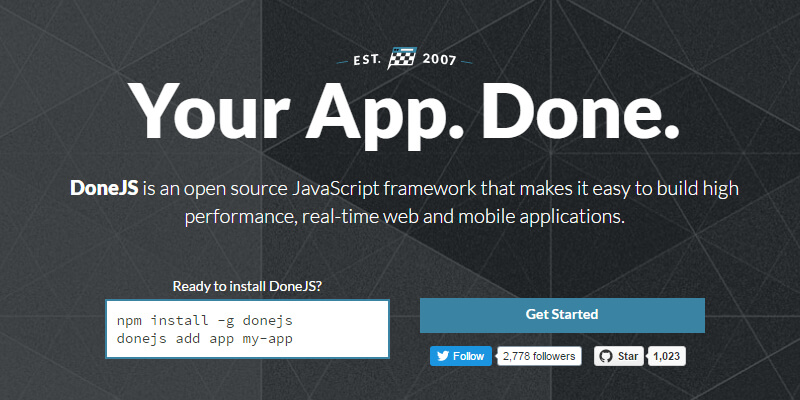
An open source JavaScript framework to build high performance and real-time web applications, as well as mobile apps for multiple platforms. It improves the usability of the apps, supports multiple browsers, enhances the performance and stability thanks to progressive loading and minimal data requests, and more.
The post donejs: App & Web Development JavaScript Framework appeared first on ByPeople.
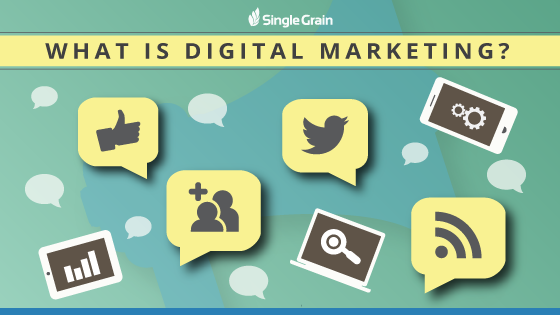
This post originally appeared on Single Grain, a growth marketing agency focused on scaling customer acquisition.
“Digital marketing” is a relatively new term that has rapidly come into prominence over the last decade, and as Ron Burgundy might say… “It’s kind of a big deal.”
To provide the simplest definition, digital marketing is an umbrella term for the marketing of products or services using digital technologies.
Online marketing is by far the most important segment of digital marketing. As traditional channels like TV and radio become less and less valuable, online marketing continues to take up bigger and bigger segments of companies’ marketing budgets, with millions of businesses marketing exclusively via the Internet.
Consider this post an introduction to digital marketing—Digital Marketing 101, if you will—which breaks down the most common channels and gives you a comprehensive framework for understanding this ever-evolving industry.
What Is the Purpose of Digital Marketing?
Like any form of marketing, the purpose of digital marketing is to promote and sell a product or service. More specifically, the purpose of digital marketing is to connect a business or organization with its target audience via digital channels.
There are currently over 3.3 billion Internet users worldwide, with this number increasing every day. Technological device ownership continues to increase as well, with 92% of U.S. adults owning at least a cellphone.
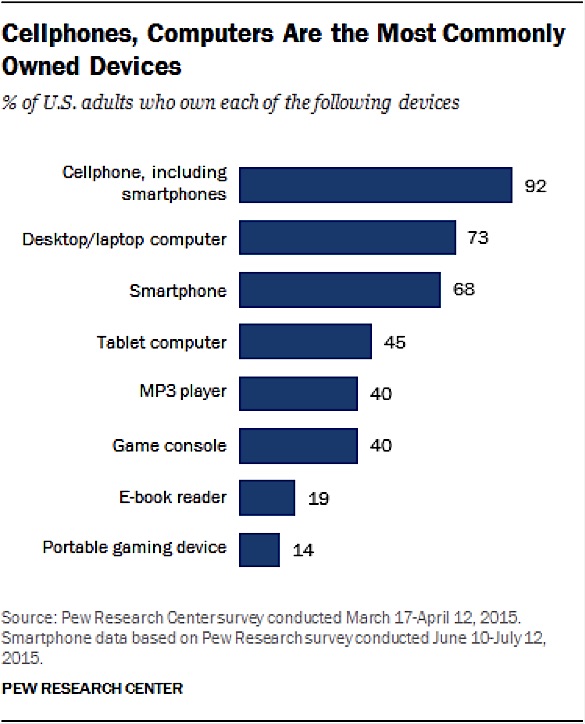
The goal of digital marketing is to utilize these numerous devices, often via the Internet, to connect segments of users with relevant businesses. Marketers will use a variety of methods to target and reach out to users in order to grab their attention and begin the process of selling to them.
And thanks to the increased use of these digital devices, businesses around the globe are increasingly making digital marketing their primary focus:
- 71% of companies plan to increase their digital marketing budgets this year (Source: Webbiquity)
- On average, 60% of a marketer’s time is devoted to digital marketing activities, fueling demand for digital marketing skills (Source: Smart Insights and Ecommerce Expo)
- One third of businesses are planning to introduce a Digital Transformation program and one third already have (Source: Smart Insights and TFM&A)
- Digital content creation and management now claim the second-largest share of digital marketing budgets (Source: KaPost)
- 28% of marketers have reduced their traditional advertising budget to fund more digital marketing (Source: CMO Council)
- 73% of B2B marketers use video as a content marketing tactic, and 7% of marketers plan on increasing their YouTube marketing (Source: Content Marketing Institute)
One of the things that separates digital from traditional marketing is the capabilities of modern technology. Digital marketers are focused primarily on targeted, measurable activities. They want to zero-in on the “right” audience and measure the results of their efforts. In the past, targeting looked like taking out a regional TV ad or running an ad in a niche magazine, but today’s technology allows for a much more refined, measurable approach.
For example, a digital marketer today can run a Facebook advertisement targeting only 20-year-olds interested in the band Coldplay. They can see every view, like, comment, and click and then use a tracking pixel to see exactly what people do after they click on the ad. This data can then be used to create ads that perform better.
The Digital Conversion Funnel
In order for us to dig into the various digital marketing channels themselves, we first need to understand the overall process in which they fit.
Digital marketing is typically built around acquiring and funneling users through a “sales” or “conversion” process often referred to as a “funnel.” The basic Digital Conversion Funnel looks like this:
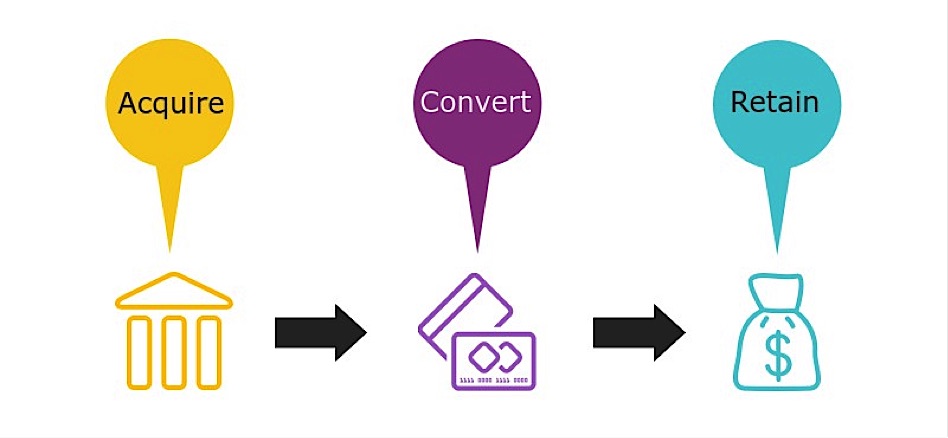
At its most basic, this process is a simple progression from acquisition to conversion to retention. This model is fairly universal and can be applied to virtually any business. Leads are acquired, converted to customers, and then retained for additional transactions.
As we get more detailed, we begin to exclude certain business models, but for the sake of reference, the most common digital conversion funnel currently in use looks something like this, taken from Digital Marketer’s guide to CVO:
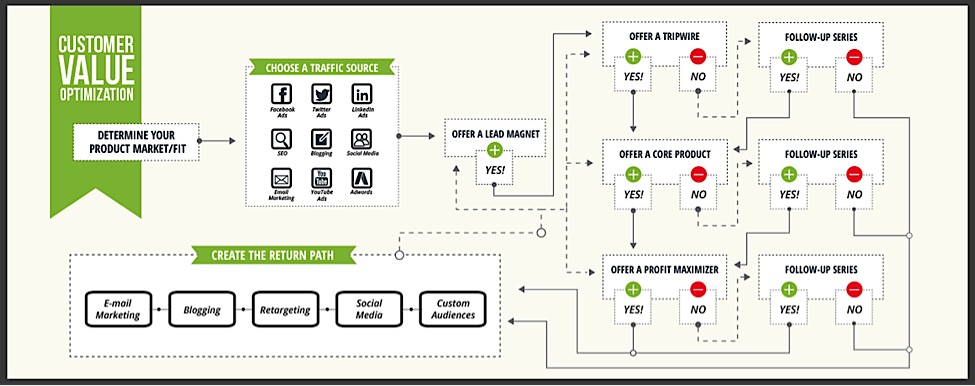
Unlike traditional marketing which is focused primarily on new customer acquisition, digital marketing is highly active throughout the entire conversion process. Once you’ve acquired new leads, you must continue to market to them in order to convert them into a customers and upsell them on additional products.
Acquisition: Common Channels For Acquiring Traffic
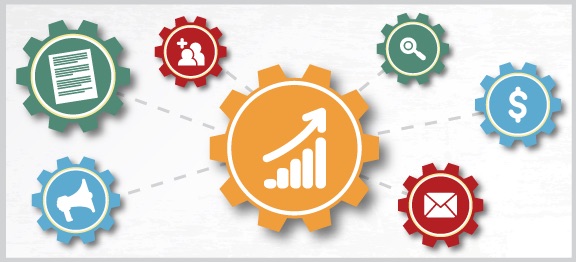
Since businesses can’t take people through their full sales process on Facebook, Google, etc., the first step for most digital marketers is getting people to visit their website. This is called acquiring “traffic,” and it’s the first step of the conversion funnel we mentioned earlier.
There are currently 7 primary channels used to acquire traffic:
- Search Engine Optimization
- Paid Advertising
- Social Media Marketing
- E-mail Marketing
- Content Marketing
- Influencer Marketing
These channels offer businesses a scalable way to acquire and increase traffic over an indefinite period of time. Furthermore, they have become so prominent that it would be fairly easy to find a full-time job specific to any one of these categories.
Let’s take a closer look at each channel.
1. Search Engine Optimization (SEO)
Search Engine Optimization (SEO) is the process of maximizing the number of visitors to a particular website by ensuring that the site appears high on the search engine results pages (SERPs).
For example, if you wanted to make a rock climbing website appear first on the SERPs when someone searches for “rock climbing gear,” the techniques and processes you use to attempt that would be called SEO.
Search engines work by using software applications called “crawler bots” to systematically browse the web and send back information on the millions of browsed pages. This data is then indexed via the search engine’s algorithm in order to provide relevant results when a user searches for a given keyphrase.
When Google launched in 1998, its PageRank system provided a new level of relevancy for keyphrase search results, and by 2000 it had become THE search engine to use, a position it maintains to this day:
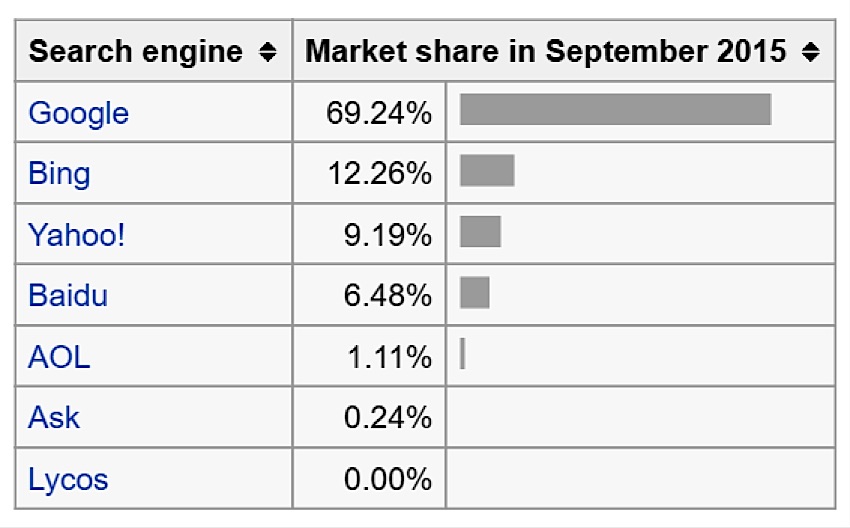
SEO was one of the first dedicated marketing channels to revolutionize how businesses approached online marketing. Some consider it to be THE first meaningful online marketing channel.
While SEO has changed drastically within the last 10 years, modern practices can be broken down into two significant sections:
- On-Page SEO
- Off-Page SEO
On-page SEO is the practice of optimizing individual web pages in order to rank higher and earn more relevant traffic in search engines. On-page refers to both the content and HTML source code of a page that can be optimized.
In other words, on-page SEO covers everything you can do on your own website to improve search engine visibility.
Common on-page SEO techniques include:
- SEO-friendly permalink URLs
- Keyphrase optimized meta tags
- Multiple media types targeting same keyphrase
- Authoritative outbound links
- Improving site loading speed
- Internal cross-linking
- Lengthy, in-depth content
These techniques tune a website’s content and framework to help provide crawler bots with the correct information.
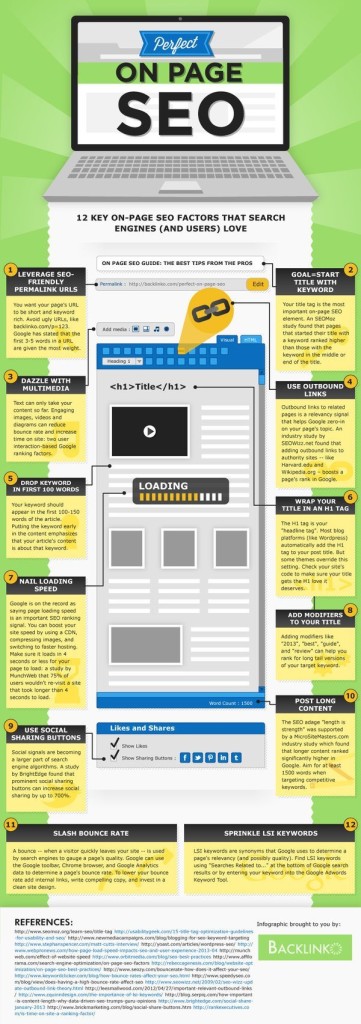
(Source:Backlinko)
To learn more about on-page SEO, check out these guides:
- A Visual Guide to Keyword Targeting and On-Page SEO by Rand Fishkin
- On-Page SEO: Anatomy of a Perfectly Optimized Page by Brian Dean
Off-page SEO is the practice of optimizing a website’s search engine visibility through off-site backlinks and other external signals. Branding and overall web presence play a role in this equation, but by far the biggest component of off-page SEO is generating backlinks.
Part of what made Google’s PageRank so revolutionary was the inclusion of external factors, namely backlinks, into the ranking algorithm. Google’s founders hypothesized that if tons of other websites were linking to a page (called a backlink), it must be a valuable resource and one that search engines users would want to find as well.
In the early days, SEO practitioners would game the system by creating thousands of websites for the sole purpose of sending backlinks to the website they wanted to optimize. As Google’s algorithm has evolved, however, the vast majority of these practices have been rendered ineffective, and now backlinks from legitimate, authoritative sites are needed in order to improve search rankings.
Effective strategies for grabbing more backlinks, also called " link building ," include:
- Writing guest posts
- Creating shareable infographics
- Get included in resource lists and directories
- Write and promote case studies
- Sponsor sites that will link to sponsors
- Buy listings with trust mark brands like BBB or Truste
- Offer your website to replace dead links

These techniques (and many others) will increase the number of sites linking to your site, which will improve your site’s prominence in relevant search results.
For additional resources on link building, click on the links below:
- Link Building Tactics: The Complete List by Jon Cooper
- Ultimate Guide to Link Building with Content by Eric Siu
2. Paid Advertising & Acquisition
Paid acquisition is any form of advertising or traffic acquisition in which a business pays directly for incoming traffic.
The most common pricing models for paid acquisition include:
- Cost Per Impression (CPM)
- Cost Per Click (CPC)
- Cost Per Lead (CPL)
With Cost Per Impression (CPM), advertisers pay for ad views, typically in units of 1,000 views, which is where the CPM acronym comes from. CPM stands for “cost per mille” (“mille” is Latin for “thousand”).
CPM was traditionally the preferred strategy for getting maximum views at a low cost. However, with the rise of bot traffic (nearly 60% of all web traffic now comes from bots) and the arrival of better performing channels, CPM has fallen out of favor in the digital marketing world.
Today, CPM is typically only used in conjunction with other models. It offers a low-cost way to increase brand awareness, and can yield minor results if targeted at the right audiences.
With Cost Per Click (CPC), advertisers pay every time their ad is actually clicked on by a viewer. CPC, more commonly referred to as “pay per click (PPC)”, allows for direct ROI tracking, making it the most popular pricing model currently used in online marketing.
CPC is often used in conjunction with a search engine, where ads can be displayed to users searching for a specific keyphrase. For example, a business could use AdWords to place a “Purchase Rock Climbing Gear” ad in Google’s search results anytime someone searches for “rock climbing gear.”
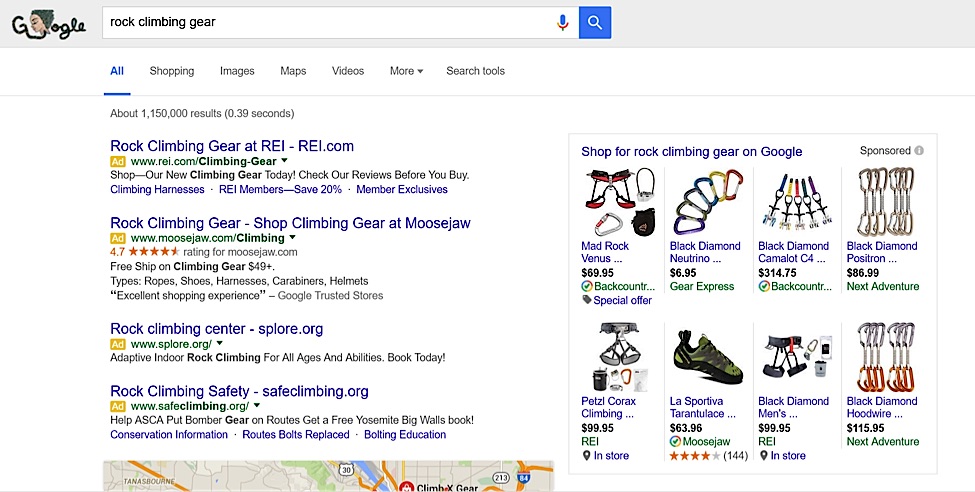
While a business’ SEO efforts might not be enough to get them on Google’s front page, they could guarantee a front page spot via AdWords if they are willing to pay enough per click. Adwords and other PPC platforms are typically run on a bidding system, where advertisers select a bidding range and the platform dynamically selects ads to display based on a combination of factors including bid price and page relevance.
More recently, CPC ads on social networks like Facebook, Twitter, and LinkedIn have begun to gain traction as well, and some have even become the preferred advertising option for certain industries.
To learn more about CPC/PPC, check out the guides below:
- The PPC Food Pyramid: A 211 Point PPC Marketing Strategy by Johnathan Dane
- PPC - The Ultimate Guide To Pay-Per-Click Marketing by Matt Umbro
Cost Per Lead (CPL) typically refers to how much it costs a business to generate or acquire a lead. CPL tends to be used more as a metric for other strategies like PPC, but it can also apply to paid lead acquisition, which is what we are talking about in this section.
Paying directly for leads tends to only makes sense in industries where customers spend high amounts per transaction or session.
Industry examples include:
- Insurance
- Travel
- Gambling
- Debt Consolidation
- Financing
For most businesses, it makes more sense to simply target traffic and set up their own lead capture system to convert traffic into leads and then customers.
3. Social Media Marketing
Social media marketing is the process of acquiring attention and website traffic through social media platforms. With the consistently increasing popularity of social media, social media marketing has become one of the quickest ways for new businesses to generate traffic without any monetary expense.
Continue reading %What Is Digital Marketing?%
Compressify * Vimgifs * Serious Study * Conversational Interfaces * Adapting to Input * React.js in patterns
Collective #231 was written by Pedro Botelho and published on Codrops.
Every week we feature a set of comics created exclusively for WDD. The content revolves around web design, blogging and funny situations that we encounter in our daily lives as designers. These great cartoons are created by Jerry King, an award-winning cartoonist who’s one of the most published, prolific and versatile cartoonists in the world […]

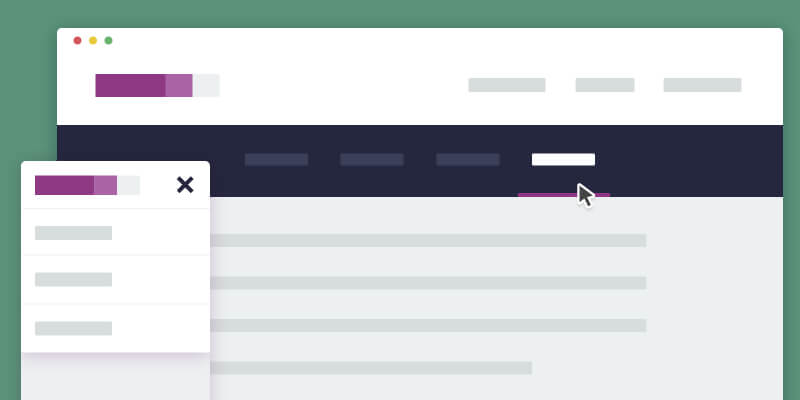 A simple CSS & jQuery navigation that auto-hides when the user scrolls down. On the other side, it becomes visible when the user scrolls up. This code has a simple structure and broad browser support, including latest versions of Chrome, Firefox and Opera.
A simple CSS & jQuery navigation that auto-hides when the user scrolls down. On the other side, it becomes visible when the user scrolls up. This code has a simple structure and broad browser support, including latest versions of Chrome, Firefox and Opera.
The post CSS & jQuery Hiding Navigation appeared first on ByPeople.
 A dark PSD template for a freelancer's portfolio. The template has simple flat elements complemented by powerful images. The typography suits the ambiance perfectly, and it is a step by step guide for the user. The template weighs 56MB.
A dark PSD template for a freelancer's portfolio. The template has simple flat elements complemented by powerful images. The typography suits the ambiance perfectly, and it is a step by step guide for the user. The template weighs 56MB.
The post Unity: Personal Portfolio PSD Template appeared first on ByPeople.